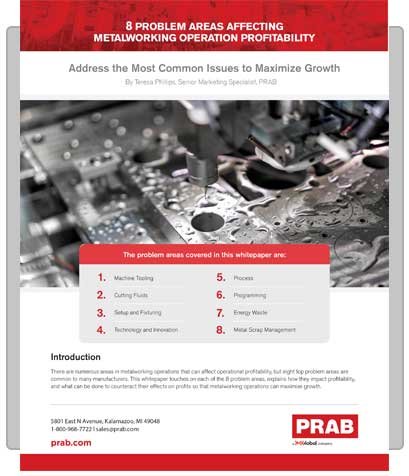
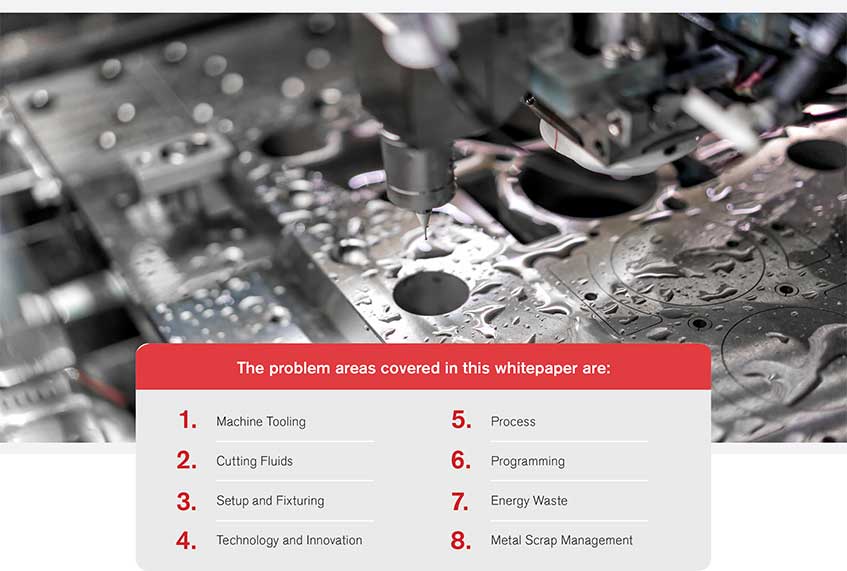
There are numerous areas in metalworking operations that can affect operational profitability, but eight top problem areas are common to many manufacturers. This whitepaper touches on each of the 8 problem areas, explains how they impact profitability, and what can be done to counteract their effects on profits so that metalworking operations can maximize growth.
Machine Tooling
A variety of metal-based materials are used in metalworking, and each machine differently based on their composition. Because of this, the proper selection of a cutting tool is imperative. The right grade tool that is designed to cut the specific metal being machined should be used.
For instance, many superalloys are used in medical device manufacturing. These hard metals can cause end mills and inserts to burn up because the operator is not running them properly for the material that is being machined.
According to an article in Production Machining Magazine, “Proper Cutting Tool Choice is Vital to Productivity,”1 research shows that although cutting tools account for only 3% of total production costs, choosing the most appropriate cutting tool for the material being machined can save as much as 15% on overall costs and improve machining productivity by 20%.
Cutting Fluids
Cutting fluid can be a costly issue if not managed properly. According to an article found in Aerospace Manufacturing and Design Magazine, “Maximizing Metal Scrap and Spent Fluid Value,”2 industry estimates indicate that metalworking fluids make up as much as 10% of the cost of a finished part. In addition, large volumes of waste coolant are costly to handle and haul away.
Most industrial cutting fluids can be recycled in-house rather easily, saving thousands of dollars per year on new cutting fluid purchases. One of the best solutions is an in-house fluid recycling system. The right fluid recycling system will provide a consistent flow of clean fluid that is the proper concentration back to machines-increasing tool life up to 25%, reducing haul-away costs by up to 90% and new coolant purchases up to 75%. Many cost reductions can be obtained with just this one simple turnkey solution.
An outdated, or inefficient recycling system can also cost manufacturers. Koss Aerospace is an example of a company that replaced an older system with a modern system for substantial cost-savings. Koss is a Tier-1 manufacturer of aircraft components and assemblies for commercial aerospace and defense customers worldwide. An article published in Modern Machine Shop Magazine, “Coolant Recycling System Improves Tool Life, Reduces Costs,”3 reports how Koss Aerospace substantially lowered operational costs by updating the company’s outdated fluid filtration system.
Koss was concerned about an excessive amount of waste cutting fluid, which also had an obvious foul odor. The company’s recycling process involved a simple coalescence system that was labor intensive and required a lot of downtime for sump maintenance. With an average sump size of 500 liters (the largest having a 1,620-liter capacity), the system also lacked the capacity to handle all 26 machining centers.
Because the old system could not capably process the quantity of fluid, the company was disposing of excess spent coolant and incurring significant haul-away costs. Koss replaced this old system with a modern Guardian Coolant Recycling System and quickly saw around a 75% savings on new coolant purchases.
Oil-based coolant can also be a challenge. About 80-90% of applications use a water miscible fluid.4 But, in precision machining applications, oil-based coolants are the best option. Oil-based coolant residue inside the machine can stain parts, which typically need to go to a washing station to be cleaned.
If the application is not in precision machining and oil-based coolant is being used, a better alternative would be to switch to a synthetic coolant if possible. A synthetic coolant contains no mineral oil. Parts come off the machine cleaner and don’t require washing and blow-off. Synthetic coolants also have excellent cooling properties that provide long life in the sump-reducing maintenance and waste.

Setup and Fixturing
Some of the greatest productivity killers in metalworking include setup time and fixturing. According to an article in Modern Machine Shop Magazine, it is common for half of setup time to be attributed to waste.5 However, by making some changes to address setup and fixturing issues, milling and turning applications can have precise quick-change fixturing with high repeatability and accuracy.
One solution is quick-change tooling. This allows the operator to switch out tooling that may have a quick-release screw. It enables the operator to easily remove the current tool and replace it with no additional setup-requiring significantly less time. With fixturing, two things that can also save time are the use of a work-holding vise that enables quick change-outs and minimizes downtime, and having multiple fixtures close at hand and ready to use. So, when the machine cycle is complete, switching parts is quick and easy.
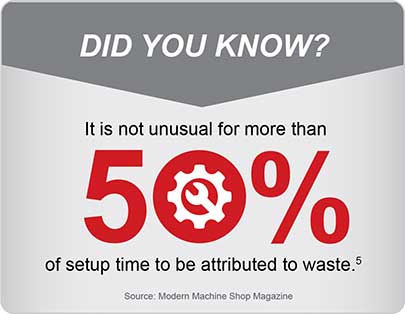
Technology and Innovation
Technology is constantly changing. Staying up-to-date with new innovations could make the competitive difference. New developments pop up every day in machines and tooling that are better solutions to productivity. Using integrated tools will expand their functionality. For example, finding a tool for a 5-axis machine that drills, countersinks, and chamfers will reduce the number of individual tools needed. Previously, three separate tools were needed to do this.
Metal Removal Rate
Changing metalworking processes to a higher metal removal rate (MRR) can really impact an operation’s revenue. The MRR is the amount of material removed (typically per minute) when machining. MRR can improve productivity by utilizing the right toolpaths, depth of cuts, speed, carbide grades, and geometries-putting more hours back to production.
Deburring is another aspect of production that can be improved. Although it may not appear that much time can be saved by changing from manually deburring to a deburring wheel, over time it all adds up to costs that can be saved in the long-run.
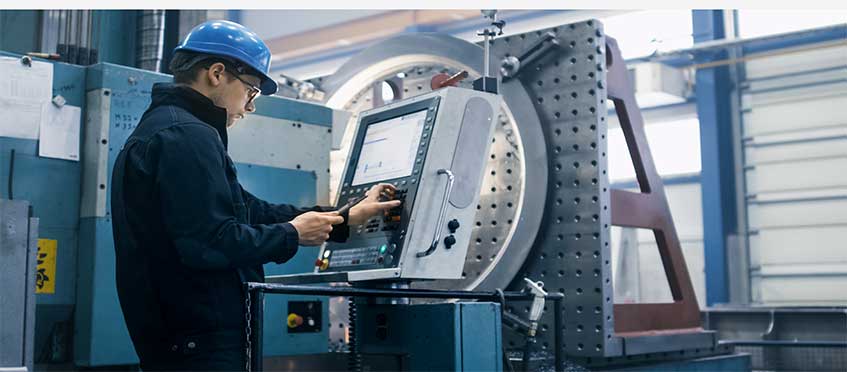
Programming
If a machine is not programmed properly there can be a lot of unneeded operational steps. By cutting out these steps, tool life can be increased and the time it takes to make parts is reduced. In addition, by eliminating unnecessary steps in the program (reducing cycle time), overtime is decreased and production is increased.
Many shop inefficiencies, such as low productivity, high maintenance, and low output, result from outdated control systems and programming. Updating or replacing these systems and/or hiring a reputable and knowledgeable automation company for programming who is experienced in the company’s industry can significantly increase a shop’s efficiency.

Manufacturers using a relay panel or outdated controls are typically dependent on manual operations. By updating a control platform, production time and downtime are reduced through steps that can be automatically controlled and give machine feedback and fault management.
Automated systems increase accuracy, which results in higher quality output, streamlined processes, and fewer errors. In addition, a reduction in quality inconsistencies leads to less waste.
In “Liberty Mutual’s 2018 Workplace Safety Index,”6 the insurance company estimated that employers paid more than $1 billion per week for workers’ compensation in 2015 for disabling, non-fatal workplace injuries. Automation reduces employee exposure to dangerous or repetitive tasks, which decreases the risk of incurring these costs.
An automated process increases output, enables faster production times and reduces costs to help operations quickly meet customer demands.
Remotely monitoring equipment provides real-time data allowing for proactive actions when maintaining equipment and production schedules. For example, KMC Global Controls & Automation, based in Kalamazoo, Michigan, works with manufacturers to program their machines to reduce labor costs with such features as maintenance reminders, interactive fault screen controls, human-machine interface (HMI) screens designed with the user in mind, and cloud-based machine monitoring that can indicate machine energy wasters that could be shut off during periods when they are not in use.
Energy Waste
The main offenders of energy waste are the operations that run for periods of time without cause. Conveyor motors, blowers, pumps, vessel agitation, and blending are a few examples of equipment and processes that are left to run for long periods of time even when product or materials are not being produced.
Even small motors running idle draw electricity, and this wasted energy adds up over time:
Aside from simple energy saving efforts, other things can be done to increase energy efficiency and lower costs including:
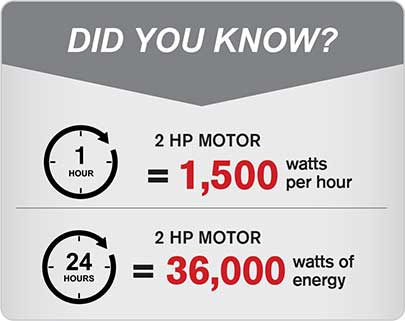
Metal Scrap Management
Manually handling and/or failing to process metal scrap in-house before it is sent to the scrap dealer takes up valuable space, accrues high haul-away costs, takes operators away from production, and results in a reduced price from the scrap dealer. Metal scrap processing equipment is available to automate this process. Scrap processing equipment reduces large piles of turnings to small chips and separates the chips from fluid. This allows for a larger payload to the scrap dealer, and, because the chips are dry, the scrap dealer will typically offer a higher price per pound. Examples of this processing equipment includes:
In addition, in an article written by The Fabricator, “5 Steps to get the Most out of Scrap Metal,”8 Fortis Metal Management in Texas lists more ways to profit from scrap from a recycler’s point of view. Some of the ways listed include:
1. Tying the Negotiated Price to an Index
Ensure pricing is tied to a defined commodity-market index for security when the market falls and to benefit when the market rises.
2. Reverse-engineer the Price Differential
Factor in what must happen to the scrap before it’s sent to the recycler such as shipping, processing costs, and what recyclers in the area are demanding.
3. Stay on Top of Load and Tracking Reports
Often, when a check from the scrap company arrives at the end of the month, not all pickup receipts make it into the office. And sometimes the scale tickets don’t match what’s itemized on the check from the scrap dealer.
4. Look out for Downgrades
Pay attention to what is in the bin to make sure metals are not being mixed. An example of this is with stainless steel. If ferrous material finds its way into a bin of nonferrous scrap the entire load is downgraded.
5. Request Third-party Weight Verification
Several times a month, ask to see a loaded truck’s weight reading from a public scale. These third-party requests should be done randomly. Then compare the third-party report (with date/time stamp) with the scrap dealer’s scale report. These should be nearly the same recorded weight (with a certain tolerance window).
There are many ways to maximize profits in the metalworking operation by focusing on these eight areas. The best course of action is to prioritize each one based on which will save the most money. Then, tackle each area one at a time.

Teresa Phillips is the Senior Marketing Specialist for PRAB Inc. and has over 18 years of marketing experience within the manufacturing sector. PRAB is a leading manufacturer of engineered conveyors and equipment for processing turnings, chips and metalworking fluids. PRAB also designs and builds industrial wastewater treatment systems.
1 Drori, Gidi, and Iscar Metals, Inc. “Proper Cutting Tool Choice Is Vital to Productivity.” Production Machining, Production Machining, 20 Oct. 2015 – https://www.productionmachining.com/columns/proper-cutting-tool-choice-is-vital-to-productivity
2 Hook, Mike. “Maximizing Metal Scrap Spent Fluid Value.” Aerospace Manufacturing and Design, 1 May 2019 – http://magazine.aerospacemanufacturinganddesign.com/article/may-2019/maximizing-metal-scrap-spent-fluid-value.aspx
3 Plaskett, Eli. “Coolant Recycling System Improves Tool Life, Reduces Costs.” Modern Machine Shop, 23 Jan. 2019 – https://www.mmsonline.com/blog/post/coolant-recycling-system-improves-tool-life-reduces-costs
4 Emerson, Melissa. “Should You Be Using an Oil Based Coolant?” Firetrace International, 29 July 2019 – https://www.firetrace.com/fire-protection-blog/should-you-be-using-an-oil-based-coolant
5 Lynch, Mike. “What Percentage Of Your Setup Time Is Waste?” Modern Machine Shop, Modern Machine Shop, 1 May 1999 – https://www.mmsonline.com/columns/what-percentage-of-your-setup-time-is-waste
6 “2018 Workplace Safety Index: The Top 10 Causes of Disabling Injuries.” Liberty Mutual Insurance, 2018 – https://viewpoint.libertymutualgroup.com/article/2018-workplace-safety-index/
7 Phillips, Teresa, and Larry West. “White Paper: Maximizing Industrial Energy Efficiency.” KMC Global Controls Automation, 14 Feb. 2020 – https://www.kmcautomation.com/white-paper-maximizing-industrial-energy-efficiency/
8 Wolff, Jason. “5 Steps to Get the Most out of Scrap Metal.” The Fabricator, 1 June 2019 – https://www.thefabricator.com/thefabricator/article/metalsmaterials/5-steps-to-get-the-most-out-of-scrap-metal